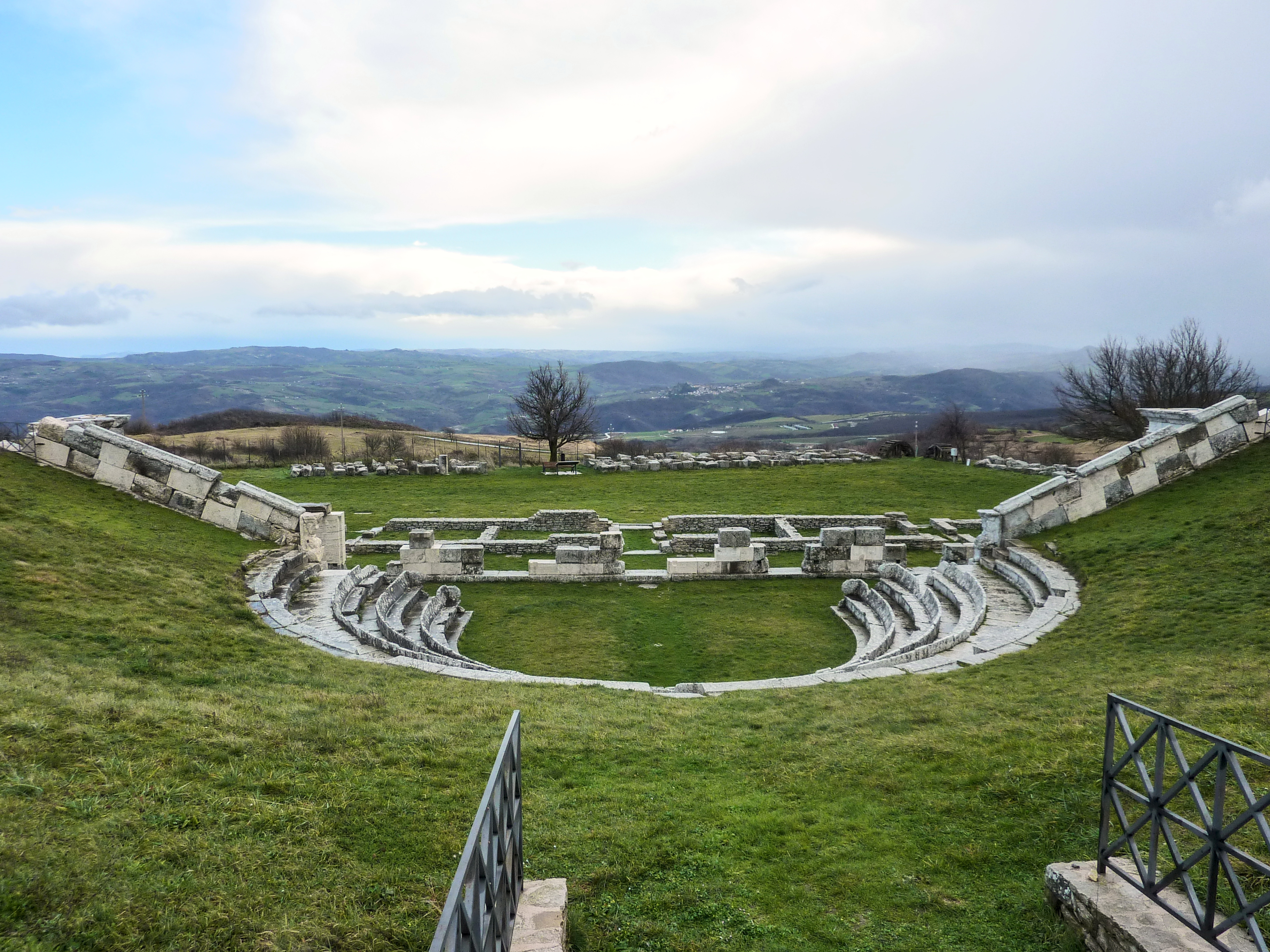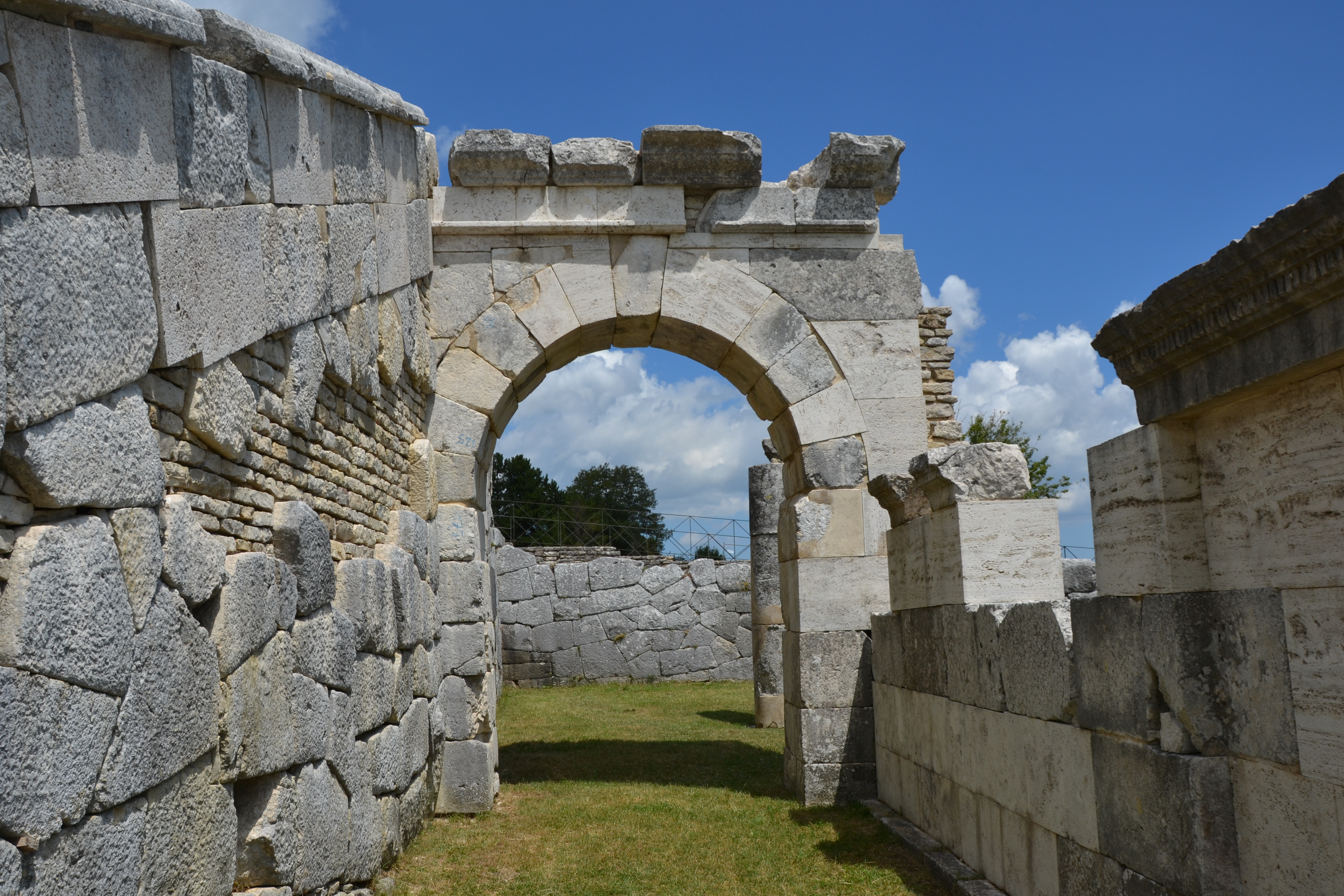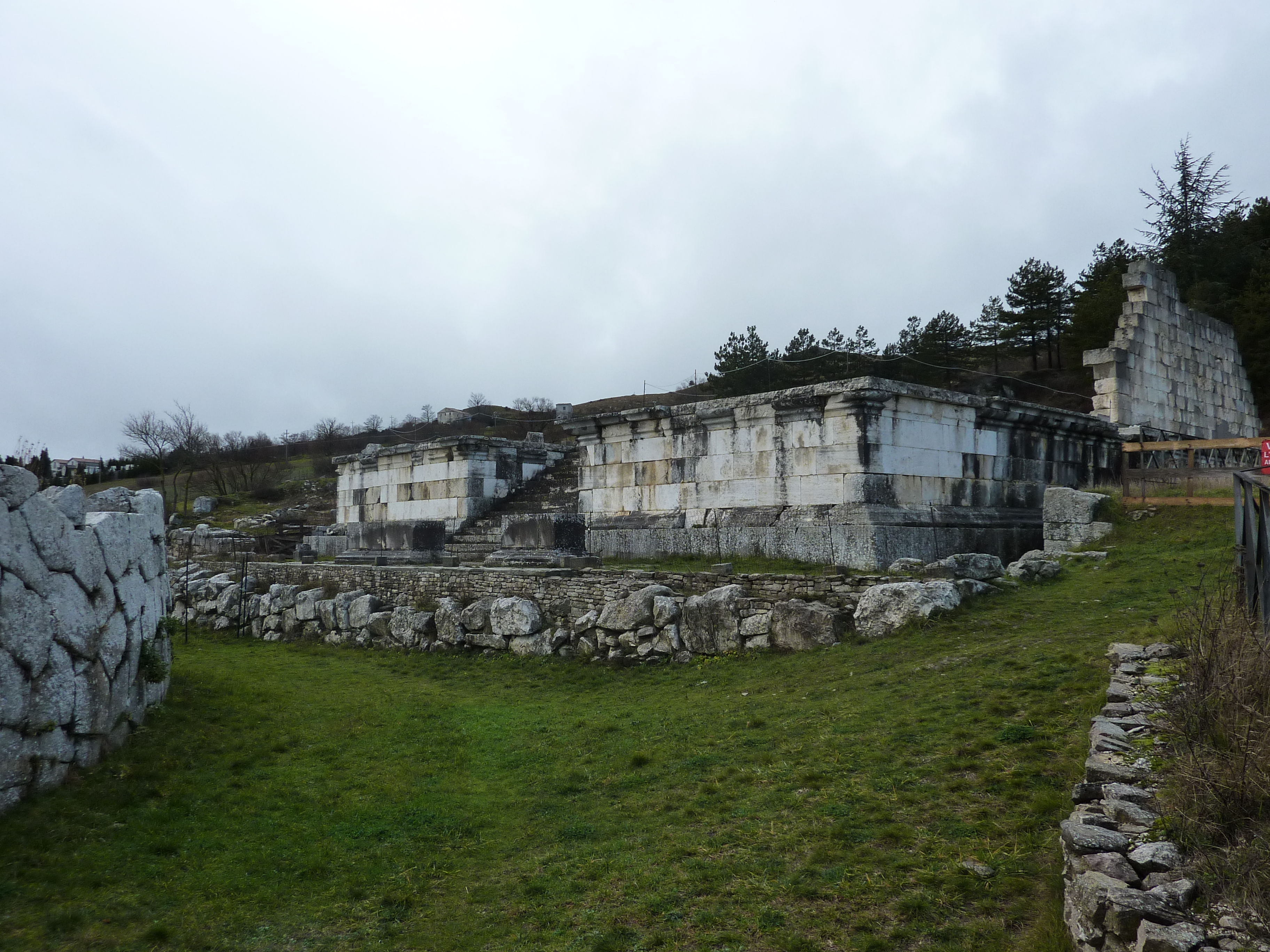Pietrabbondante on:
[Wikipedia]
[Google]
[Amazon]
Pietrabbondante is a ''
 Pietrabbondante's earliest known inhabitants were the Samnites, who arrived in Pietrabbondante in the 6th century BC. Many historians believe that it was home of the assemblies of the Samnite federal government. Although earlier scholarship thought this was the Samnite town called " Bovianum", this is now believed to be incorrect and the site is viewed as a Samnite sanctuary. The site has a single temple, a temple-theater complex, and numerous other structures. There seems to have been significant decrease in use after the loss of the Samnites and allies during the Social Wars, at the hands of
Pietrabbondante's earliest known inhabitants were the Samnites, who arrived in Pietrabbondante in the 6th century BC. Many historians believe that it was home of the assemblies of the Samnite federal government. Although earlier scholarship thought this was the Samnite town called " Bovianum", this is now believed to be incorrect and the site is viewed as a Samnite sanctuary. The site has a single temple, a temple-theater complex, and numerous other structures. There seems to have been significant decrease in use after the loss of the Samnites and allies during the Social Wars, at the hands of
 On the slope of Monte Saraceno, the Samnites built a complex of worship consisting of a theater, a temple and two arcaded buildings on both sides. Work began in the late 2nd century BC and was completed in 95 AD. The building, as articulated, was intended both for worship and for institutional activities.
On the slope of Monte Saraceno, the Samnites built a complex of worship consisting of a theater, a temple and two arcaded buildings on both sides. Work began in the late 2nd century BC and was completed in 95 AD. The building, as articulated, was intended both for worship and for institutional activities.
 The theater-temple complex is located on the outskirts of Pietrabbondante about above sea level, next to another small temple with arcaded shops from a previous era (200 BC). To build it, the Samnites situated two terraces along the side of the mountain, but at different levels on a single
The theater-temple complex is located on the outskirts of Pietrabbondante about above sea level, next to another small temple with arcaded shops from a previous era (200 BC). To build it, the Samnites situated two terraces along the side of the mountain, but at different levels on a single
 The theater sits on the site of an ancient (3rd century BC) Ionic temple portico, which was destroyed by Hannibal in 217 BC. The temple, measuring , lies behind the amphitheater. Today, the only structures remaining are the base (
The theater sits on the site of an ancient (3rd century BC) Ionic temple portico, which was destroyed by Hannibal in 217 BC. The temple, measuring , lies behind the amphitheater. Today, the only structures remaining are the base (
 A statue depicting the ancient Samnite soldier as he had represents the sacrifice of the fallen Pietrabbondantesi in
A statue depicting the ancient Samnite soldier as he had represents the sacrifice of the fallen Pietrabbondantesi in
Official website
Pro Loco Site
{{Authority control Cities and towns in Molise
comune
The (; plural: ) is a local administrative division of Italy, roughly equivalent to a township or municipality. It is the third-level administrative division of Italy, after regions ('' regioni'') and provinces (''province''). The can also ...
'' (municipality) in the Province of Isernia
The province of Isernia ( it, provincia di Isernia) is a province in the region of Molise in Italy. The provincial capital is the city Isernia and the president of the province is Alfredo Ricci. The province of Isernia has an area of and a popu ...
in the Italian
Italian(s) may refer to:
* Anything of, from, or related to the people of Italy over the centuries
** Italians, an ethnic group or simply a citizen of the Italian Republic or Italian Kingdom
** Italian language, a Romance language
*** Regional Ita ...
region Molise
it, Molisano (man) it, Molisana (woman)
, population_note =
, population_blank1_title =
, population_blank1 =
, demographics_type1 =
, demographics1_footnotes =
, demographics1_title1 =
, demographics1_info1 ...
, located about northwest of Campobasso
Campobasso (, ; nap, label= Campobassan, Cambuàsce ) is a city and ''comune'' in southern Italy, the capital of the region of Molise and of the province of Campobasso. It is located in the high basin of the Biferno river, surrounded by Sa ...
and about northeast of Isernia
Isernia () or, in Pliny and later writers, ''Eserninus'', or in the Antonine Itinerary, ''Serni''. is a town and ''comune'' in the southern Italian region of Molise, and the capital of province of Isernia.
Geography
Situated on a rocky crest ...
.
Pietrabbondante borders the following municipalities: Agnone
Agnone is a ''comune'' in the province of Isernia, in the Molise region of southern Italy, some northwest of Campobasso. Agnone is known for the manufacture of bells by the Marinelli Bell Foundry. The town of Agnone proper is complemented with ...
, Castelverrino, Chiauci
Chiauci is a ''comune'' (municipality) in the Province of Isernia in the Italian region Molise, located about northwest of Campobasso and about northeast of Isernia.
Chiauci borders the following municipalities: Civitanova del Sannio
Civitanova ...
, Civitanova del Sannio
Civitanova del Sannio is a ''comune'' (municipality) in the Province of Isernia in the Italian region Molise, located about northwest of Campobasso and about northeast of Isernia.
Geography
Civitanova del Sannio borders the following municipalit ...
, Pescolanciano and Poggio Sannita
Poggio Sannita is a ''comune'' (municipality) in the Province of Isernia in the Italian region Molise, located about northwest of Campobasso and about northeast of Isernia. Poggio Sannita (Caccavone in Poggese) is on a promontory surrounded by ...
.
History
Samnites and Romans
 Pietrabbondante's earliest known inhabitants were the Samnites, who arrived in Pietrabbondante in the 6th century BC. Many historians believe that it was home of the assemblies of the Samnite federal government. Although earlier scholarship thought this was the Samnite town called " Bovianum", this is now believed to be incorrect and the site is viewed as a Samnite sanctuary. The site has a single temple, a temple-theater complex, and numerous other structures. There seems to have been significant decrease in use after the loss of the Samnites and allies during the Social Wars, at the hands of
Pietrabbondante's earliest known inhabitants were the Samnites, who arrived in Pietrabbondante in the 6th century BC. Many historians believe that it was home of the assemblies of the Samnite federal government. Although earlier scholarship thought this was the Samnite town called " Bovianum", this is now believed to be incorrect and the site is viewed as a Samnite sanctuary. The site has a single temple, a temple-theater complex, and numerous other structures. There seems to have been significant decrease in use after the loss of the Samnites and allies during the Social Wars, at the hands of Lucius Cornelius Sulla
Lucius Cornelius Sulla Felix (; 138–78 BC), commonly known as Sulla, was a Roman general and statesman. He won the first large-scale civil war in Roman history and became the first man of the Republic to seize power through force.
Sulla ha ...
(89 BC).
Excavations in the 1840s brought to light sections of marble statues, clay tools, coins, weapons, etc. A very notable archeological find is the temple and the theater built of polygonal limestone that is a rare example of such a structure built by the Samnites.
Lombard
After theLombards
The Lombards () or Langobards ( la, Langobardi) were a Germanic people who ruled most of the Italian Peninsula from 568 to 774.
The medieval Lombard historian Paul the Deacon wrote in the '' History of the Lombards'' (written between 787 an ...
of the 8th century, it came to be designated by the name "Petra Habundante". The current name is relatively recent and is etymologically justified because the area is rich in limestone
Limestone ( calcium carbonate ) is a type of carbonate sedimentary rock which is the main source of the material lime. It is composed mostly of the minerals calcite and aragonite, which are different crystal forms of . Limestone forms whe ...
rocks and debris. In 957, the city was the capital of one of thirty-four counties in which it was divided by the Duchy of Benevento
The Duchy of Benevento (after 774, Principality of Benevento) was the southernmost Lombard duchy in the Italian Peninsula that was centred on Benevento, a city in Southern Italy. Lombard dukes ruled Benevento from 571 to 1077, when it was conq ...
. Noble families intertwined with governing Pietrabbondante include Cantelmo, the Carafa, the Marquises, D'Andrea, and finally to D'Alessandro.
Present
Currently the town of Pietrabbondante is a tourist site. It is situated at the base of towering rocks called "Morg" Caraceni, which are located at the foot of a mountain on whose slopes have been found many megalithic remains. The town is also rich in flora, as there in places bordering large expanses of conifers and hardwoods.Main sights
Ancient temple and theater
Theater
axis
An axis (plural ''axes'') is an imaginary line around which an object rotates or is symmetrical. Axis may also refer to:
Mathematics
* Axis of rotation: see rotation around a fixed axis
* Axis (mathematics), a designator for a Cartesian-coordinat ...
. The top two buildings housed the temple and side porches. The overall size of the area is .
The theater consists of two elements: the auditorium
An auditorium is a room built to enable an audience to hear and watch performances. For movie theatres, the number of auditoria (or auditoriums) is expressed as the number of screens. Auditoria can be found in entertainment venues, community ...
and the building stage, which are linked together by two stone arches. The auditorium is capable of holding up to 2,500 spectators and has excellent acoustics. Each of the seats was created from a single stone block with the dorsal elegantly thrown backwards; signs at both ends of each row reserved them for judges, priests, and so on. On both sides of the orchestra, retaining walls of the embankment (analemma
In astronomy, an analemma (; ) is a diagram showing the position of the Sun in the sky as seen from a fixed location on Earth at the same mean solar time, as that position varies over the course of a year. The diagram will resemble a figure ...
) end with atlases carved in stone (like the Odeon of Pompeii, however, the material is made of soft tuff
Tuff is a type of rock made of volcanic ash ejected from a vent during a volcanic eruption. Following ejection and deposition, the ash is lithified into a solid rock. Rock that contains greater than 75% ash is considered tuff, while rock ...
). The entire embankment is supported by large semicircular and polygonal blocks processed by cutting without regular contours.
Temple
podium
A podium (plural podiums or podia) is a platform used to raise something to a short distance above its surroundings. It derives from the Greek ''πόδι'' (foot). In architecture a building can rest on a large podium. Podiums can also be used ...
) and the eight columns that rose in front. The columns were topped with Corinthian order capitals., and had clad pottery decorated in the back with three segments paved with fine mosaic
A mosaic is a pattern or image made of small regular or irregular pieces of colored stone, glass or ceramic, held in place by plaster/mortar, and covering a surface. Mosaics are often used as floor and wall decoration, and were particularly pop ...
s. Each of the mosaics were dedicated to different deities.
The roof was built with trusses, stringers, plates and tiles, each weighing , from Venafro
Venafro (Latin: ''Venafrum''; Greek: ) is a ''comune'' in the province of Isernia, region of Molise, Italy. It has a population of 11,079, having expanded quickly in the post-war period.
Geography
Situated at the foot of Mount Santa Croce, elevat ...
. Cells and columns made up its foundations, so the mighty outer wall of the podium served as a simple decorative coating. Elaborate cornices decorated with floral motifs and ram's heads topped the altars. The segments are usually darker than the original, like the steps of the dark sunken staircase. On the left side, an inscription in Oscan
Oscan is an extinct Indo-European language of southern Italy. The language is in the Osco-Umbrian or Sabellic branch of the Italic languages. Oscan is therefore a close relative of Umbrian.
Oscan was spoken by a number of tribes, including ...
recalls Statius Claro, an important figure who built at his expense half of the podium. On the back of the temple, in the containment wall of the ground (north side), a phallic
A phallus is a penis (especially when Erection, erect), an object that resembles a penis, or a mimesis, mimetic image of an erect penis. In art history a figure with an erect penis is described as ithyphallic.
Any object that symbolically— ...
symbol is carved on a block for protection against misfortune. At the sides of the podium, two porches with remains of buildings used as shops and various services complement the overall harmony.
Discovery
The monument in the 2nd century AD was abandoned and completely buried byalluvium
Alluvium (from Latin ''alluvius'', from ''alluere'' 'to wash against') is loose clay, silt, sand, or gravel that has been deposited by running water in a stream bed, on a floodplain, in an alluvial fan or beach, or in similar settings. ...
. The excavations that ultimately discovered the site were conducted in several phases: in 1857 and 1858, by the Bourbons
The House of Bourbon (, also ; ) is a European dynasty of French origin, a branch of the Capetian dynasty, the royal House of France. Bourbon kings first ruled France and Navarre in the 16th century. By the 18th century, members of the Spani ...
, in 1871–72, out of interest of the Province, and in 1959 and subsequent years through the intervention of the Archaeological Superintendent of Molise.
Church of Santa Maria Assunta
The church of Pietrabbondante is dedicated to Santa Maria Assunta. During the feast of the saint, which falls on 15 August, a procession of women carry on their shoulders the saint's effigy. The church stands on a hilltop in front of a bare rock outline called "Morgia of the Cross". The bell tower and its three belfries feature built-in stonework on top of which stands the cross; the center bell tower features a Baroque portal adorned with floral pattern, and includes a small niche in which there is a sculpture depicting Santa Maria Assunta herself. Above the portal is also a large window in the Baroque style. The perimeter wall rests on a massive support structure built with huge limestone blocks from the nearby archaeological site. The interior has undergone numerous transformations over the centuries and the present reflects a Baroque style. Subsequent to 1696, the building took the shape of a Latin cross, divided into three naves bounded by large plastered square pillars, which support the six arches. In the right aisle, a sarcophagus was found during the renovation work after the 1990 earthquake near the statues of St. Nicholas of Bari, St. Francis of Paola (1867) and St. Roch the Confessor. In the transept of the right aisle is the canvas by Angelico Zarlenga dedicated to St. Vincent Ferrer, which commemorates the destruction of housing duringWorld War II
World War II or the Second World War, often abbreviated as WWII or WW2, was a world war that lasted from 1939 to 1945. It involved the vast majority of the world's countries—including all of the great powers—forming two opposing ...
and the return of numerous prisoners from concentration camps. At the front of the same transept there is a baptismal font made of marble.
War memorial
World War I
World War I (28 July 1914 11 November 1918), often abbreviated as WWI, was one of the deadliest global conflicts in history. Belligerents included much of Europe, the Russian Empire, the United States, and the Ottoman Empire, with fightin ...
. An immigrant committee formed by Alessandro DiTullio in America raised money in July 1919 to remember the war victims. Subsequently, in February 1920, the Pietrabbondante City Council proceeded to erect the war memorial with these funds.
References
External links
Official website
Pro Loco Site
{{Authority control Cities and towns in Molise